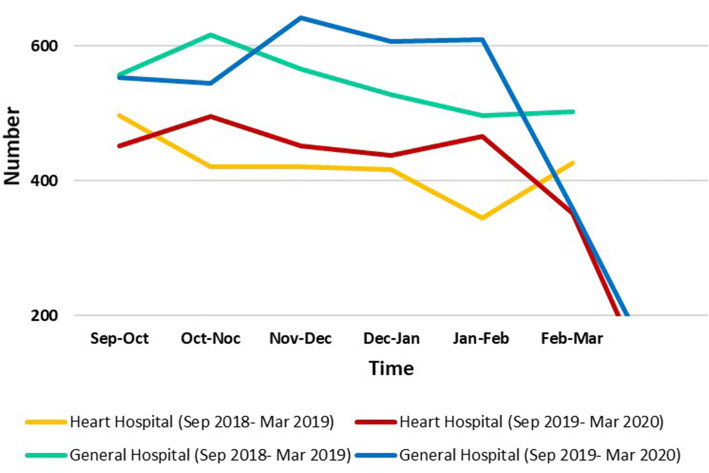Sirs,
In December 2019, severe acute respiratory syndrome Coronavirus 2 (SARS-COV-2), termed “novel COVID-19”, emerged in China and was considered a pandemic by the World Health Organization (WHO) on March 11, 2020 [1]. So far, a sizable population of the world has been affected [2] and many have expired. Although an epidemic necessitates the organization of medical and health facilities to control the crisis, the provision of services to other patients, who may have serious conditions, should not be neglected because of the catastrophic consequences.
In Iran, 24/7 primary percutaneous coronary intervention (PCI) as the standard treatment strategy for patients with ST-elevation myocardial infarction (STEMI) [3–7] was launched in September 2015 to achieve a fair distribution of healthcare resources. Currently, 49 general and heart hospitals provide these services, with 48 915 patients having undergone primary PCI thus far.
With the outbreak of the Coronavirus, the first case of COVID-19 was officially reported on February 19, 2020. As is shown in Fig. 1, we have found a significant drop (approximately 25–40%) in the number of documented STEMI patients who have undergone primary PCI in our 24/7 primary PCI-capable hospitals.
Fig. 1.
Trend of primary percutaneous coronary intervention in general and heart hospitals in the fall and winter of the last 2 years
What may be responsible for this decline is patients’ fear of contamination with the Coronavirus in hospitals or the exhaustion of the entire health system resources by COVID-19 patients. On the other hand, the manifestation of critical STEMI with dyspnea and pulmonary edema could be mistaken with the Coronavirus features, resulting in the management of the patient as a COVID-19 case from the outset. In the worst-case scenario, the patient might expire at home due to a wasted time interval between the symptom onset and the first medical contact.
According to recent reports [8–10], the number of patients undergoing primary PCI and acute coronary syndrome admissions have also dropped significantly in other countries. Indubitably, this is an extremely worrying issue with adverse long-term consequences for patients and healthcare systems.
We suggest that the general population be fully informed as regards the symptoms of STEMI by social media. We also herewith underscore the vital importance of timely referrals to designated hospitals. Moreover, STEMI patients highly suspicious of COVID-19 should be isolated and screened via laboratory and imaging tests, and the medical staff should use full personal protective equipment (PPE).
Availability of data and material
All data generated or analyzed during this study are included in this published article.
Author contributions
Conception or design of the work: SA, MS, SHM, PS, BG. Supervision of development of the work: SA, MS, PS, BG. Provision of study materials or patients and statistical expertise: SHM, PS, BG. Drafting of the article: SHM, PS, BG. Critical revision of the article for important intellectual content: SA, MS, SHM, PS, BG. Administrative, technical, or logistic support: SA, MS, BG. Final approval of the article: SA, MS, SHM, PS, BG.
Funding
None.
Compliance with ethical standards
Conflict of interest
We declare no conflict of interest.
Contributor Information
Seifollah Abdi, Email: abdiseifollah@gmail.com.
Mojtaba Salarifar, Email: mojtabasalarifar@yahoo.com.
Seyedeh Hamideh Mortazavi, Email: h-mortazavi@student.tums.ac.ir.
Parham Sadeghipour, Email: psadeghipour@hotmail.com.
Babak Geraiely, Email: bgeraiely@sina.tums.ac.ir.
References
- 1.Bedford J, Enria D, Giesecke J, Heymann DL, Ihekweazu C, Kobinger G, Lane HC, Memish Z, Oh M-D, Schuchat A. COVID-19: towards controlling of a pandemic. Lancet. 2020;28(395):1015–1018. doi: 10.1016/S0140-6736(20)30673-5. [DOI] [PMC free article] [PubMed] [Google Scholar]
- 2.WHO (2020) Coronavirus disease 2019 (COVID-19) Situation Report—77. 28(395):1015–8
- 3.Widimsky P, Wijns W, Kaifoszova Z (2012) Stent for Life: how this initiative began? Eurointervention: J EuroPCR Collab Work Group Interv Cardiol Eur Soc Cardiol 8: 8–10. 10.4244/EIJV8SPA3 [DOI] [PubMed]
- 4.Zahler D, Lee-Rozenfeld K, Ravid D, Rozenbaum Z, Banai S, Keren G, Shacham Y. Relation of lowering door-to-balloon time and mortality in ST segment elevation myocardial infarction patients undergoing percutaneous coronary intervention. Clin Res Cardiol. 2019;108(9):1053–1058. doi: 10.1007/s00392-019-01438-6. [DOI] [PubMed] [Google Scholar]
- 5.Reindl M, Tiller C, Holzknecht M, Lechner I, Eisner D, Riepl L, Pamminger M, Henninger B, Mayr A, Schwaiger JP, Klug G, Bauer A, Metzler B, Reinstadler SJ. Global longitudinal strain by feature tracking for optimized prediction of adverse remodeling after ST-elevation myocardial infarction. Clin Res Cardiol. 2020 doi: 10.1007/s00392-020-01649-2. [DOI] [PubMed] [Google Scholar]
- 6.Feistritzer HJ, Jobs A, de Waha-Thiele S, Eitel I, Freund A, Abdel-Wahab M, Desch S, Thiele H. Multivessel versus culprit-only PCI in STEMI patients with multivessel disease: meta-analysis of randomized controlled trials. Clin Res Cardiol. 2020 doi: 10.1007/s00392-020-01637-6. [DOI] [PMC free article] [PubMed] [Google Scholar]
- 7.Jäger B, Haller PM, Piackova E, Kaff A, Christ G, Schreiber W, Weidinger F, Stefenelli T, Delle-Karth G, Maurer G, Huber K, Vienna SRG. Predictors of transportation delay in patients with suspected ST-elevation-myocardial infarction in the VIENNA-STEMI network. Clin Res Cardiol Off J German Cardiac Soc. 2020;109(3):393–399. doi: 10.1007/s00392-019-01520-z. [DOI] [PMC free article] [PubMed] [Google Scholar]
- 8.Metzler B, Siostrzonek P, Binder RK, Bauer A, Reinstadler SJ. Decline of acute coronary syndrome admissions in Austria since the outbreak of COVID-19: the pandemic response causes cardiac collateral damage. Eur Heart J. 2020 doi: 10.1093/eurheartj/ehaa314. [DOI] [PMC free article] [PubMed] [Google Scholar]
- 9.Thornton J. Covid-19: A and E visits in England fall by 25% in week after lockdown. BMJ. 2020;369:m1401. doi: 10.1136/bmj.m1401. [DOI] [PubMed] [Google Scholar]
- 10.Rosenbaum L. The untold toll—the pandemic's effects on patients without Covid-19. N Engl J Med. 2020 doi: 10.1056/NEJMms2009984. [DOI] [PubMed] [Google Scholar]
Associated Data
This section collects any data citations, data availability statements, or supplementary materials included in this article.
Data Availability Statement
All data generated or analyzed during this study are included in this published article.



